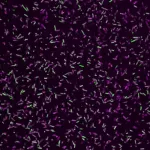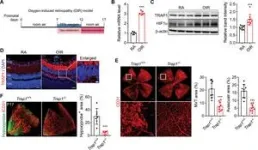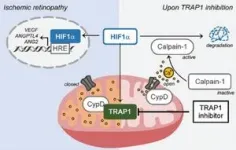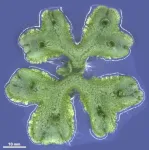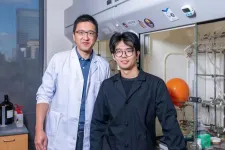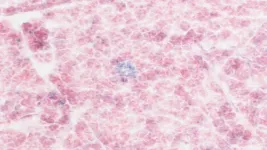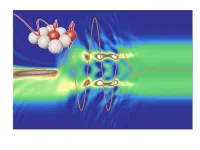(Press-News.org) The human immune system is constantly fending off a wide range of invaders – a feat that requires a diverse array of cellular troops and molecular weaponry. Although a great deal is already known about immune defense cells and the strategies they employ, many molecular details have remained elusive. Now a research team led by Professor Oliver Daumke, a lab head at the Max Delbrück Center, has managed to unravel the main activation mechanism of GBP1, a protein that plays a pivotal role in combating certain bacteria. They report in “The EMBO Journal” how the protein adopts a special conformation that enables it to encapsulate the invaders, thereby neutralizing them. “The findings help us to better understand the body’s immune defenses – and in the future may allow us to stimulate them in a more targeted way,” says Daumke.
A destructive protein coat
GBP1, short for guanylate-binding protein 1, is produced by the body’s cells in response to an infection. It binds specifically to GTP, a nucleotide and chemical energy carrier within cells, where it orchestrates the defense against bacterial pathogens like Salmonella and Shigella. In some cases these may cause severe diarrhea. Not only does GBP1 specifically activate the immune defense, it also forms a protein coat around the unwanted intruders. This destroys their membrane, making the bacteria vulnerable and preventing them from multiplying. Scientists had already known about this defense strategy, but the details of how it worked remained unclear, as did the central molecular switch in the GBP1 protein responsible for its activation.
The team used a high-resolution cryo-electron microscope, which allowed them to visualize the protein’s three-dimensional structure, to investigate each step of this mechanism. “GBP1 is initially present as a single building block. When it is activated, it folds out like a Swiss army knife,” explains the paper’s first author, Marius Weismehl, a doctoral student in Daumke’s lab.
“Thousands of these unfolded proteins then assemble into discs, which in turn stack into tubular structures,” continues Weismehl. “These tubes finally attach to the bacterial membrane, where they reform and wrap around it like a coat.” In this way, GBP1 proteins neutralize the invaders. Uncovering the details of how these large protein structures are built was the main aim of the study. “Our microscopy data impressively show how GBP1 proteins stick to the membrane surfaces like pins and join together via their heads,” says Professor Misha Kudryashev. He adds that these new findings are a crucial advance in elucidating the mechanistic functioning of GBP1.
“We have identified a molecular lever that plays a critical role in the first step of activation,” says Weismehl. The protein uses the energy stored in GTP to control this lever and activate itself. This mechanism allows the protein to change its shape so that it can bind to other dimers and form a stable protein coat around bacteria. The researchers gained these insights by specifically altering certain sites in the protein, thus revealing the different functions they perform.
“Our results uncovered for the first time the sophisticated activation mechanism of GBP1, which results in the encapsulation of pathogens with an antimicrobial protein coat,” summarizes Daumke. In the future, according to Weismehl, it will be possible to look at how the GBP1 protein assemblies interact with other players in the immune response and thus trigger downstream signaling cascades. The research team is optimistic that this fundamental knowledge of the human immune system will help better understand bacterial infectious diseases and inform new treatments that specifically enhance the immune response during infection.
Further information
A small home for a big microscope
AG Daumke
AG Kudryashev
Cryo-Electron Microscopy
iNAMES International Research School END
How a protein fights off bacteria
2024-01-24
ELSE PRESS RELEASES FROM THIS DATE:
Breakthrough technology offers promising treatment for ischemic retinopathy
2024-01-24
A groundbreaking technology with immense potential in treating ischemic retinopathy in premature infants and diabetic patients has been developed by Professor Byoung Heon Kang and his research team in the Department of Biological Sciences at UNIST, in collaboration with Professor Dong Ho Park’s team at Kyungpook National University Hospital. Ischemic retinopathy, characterized by the breakdown of the blood-retinal barrier and abnormal blood vessel growth, often leads to vision impairment and loss. The researchers have identified the critical role of a mitochondrial ...
Death rate higher than expected for patients with functional, nonepileptic seizures
2024-01-24
The death rate for patients with functional, nonepileptic seizures is higher than expected, with a rate comparable to epilepsy and severe mental illness, a Michigan Medicine-led study finds.
A team of researchers reviewed data from 700 patients who were diagnosed with functional seizures, also called psychogenic or nonepileptic seizures, between 2014 and mid-2023 and followed for a median of 15 months.
It is the largest study of its kind in the United States, matching international studies in Australia, Denmark, Sweden and the United Kingdom, all of which have nationalized health care systems.
Of the 700 patients with functional ...
National Science Foundation and The Kavli Foundation partner on call for research proposals in neurobiology and changing ecosystems
2024-01-24
The Kavli Foundation and the U.S. National Science Foundation (NSF) Directorate for Biological Sciences' Division for Integrative Organismal Systems have joined forces to launch a grant program in neurobiology and changing ecosystems. Research in this emerging field has great potential to reveal novel scientific insights that will accelerate understanding of basic biology in neural adaptation and resilience at the molecular, biophysical, cellular, and circuit levels.
“NSF’s partnership with The Kavli Foundation will enable the U.S. to advance research in this emerging and understudied field,” remarked Denise Dearing, Division ...
Facial recognition app for dogs developed to help in fight against rabies
2024-01-24
A new mobile phone-based facial recognition application for dogs has the potential to significantly improve rabies vaccination efforts in endemic areas like Africa and Asia, according to a study on the research published in the journal Scientific Reports.
Led by researchers at Washington State University, a team used the app to test its effectiveness at a rabies vaccination clinic in rural Tanzania where they microchipped, vaccinated and registered dogs. The technology proved remarkably accurate during a subsequent visit to surrounding villages once poor images and improperly recorded ...
New study unveils how plants control the production of reactive oxygen species
2024-01-24
Reactive oxygen species (ROS) are highly reactive molecules containing oxygen. These compounds, which are normal byproducts of biological processes in all living organisms such as aerobic respiration as well as photosynthesis, are highly toxic. In most cases, ROS damage cellular machinery and can trigger a harmful stress response if their levels are not kept in tight check; this is why antioxidants are an important part of our diet.
However, over the past few decades, scientists have discovered that ROS are often intentionally ...
Rice study unlocks breakthrough for breast cancer bone metastases
2024-01-24
HOUSTON – (Jan. 24, 2023) – Rice University researchers in the lab of chemist Han Xiao have identified a promising new immunological pathway to treat stubborn bone tumors, one of most prevalent forms of metastases in breast cancer patients.
“More than 70% of people with metastatic breast cancer will see the cancer cells move to bone, which can lead to skeletal-related events like bone pain, fractures, and hypercalcemia,” said Yixian Wang, a Rice graduate student in the Han lab who is a lead author on a study published in Proceedings of the National Academy of Sciences. ...
The fountain of youth is … a T cell?
2024-01-24
The fountain of youth has eluded explorers for ages. It turns out the magic anti-aging elixir might have been inside us all along.
Cold Spring Harbor Laboratory (CSHL) Assistant Professor Corina Amor Vegas and colleagues have discovered that T cells can be reprogrammed to fight aging, so to speak. Given the right set of genetic modifications, these white blood cells can attack another group of cells known as senescent cells. These cells are thought to be responsible for many of the diseases we grapple with later in life.
Senescent cells are those that stop replicating. As we age, they build up in our bodies, ...
Infants born to COVID-infected mothers have triple the risk of developing respiratory distress
2024-01-24
New UCLA-led research finds that infants born full term to mothers who were infected with COVID-19 during pregnancy had three times the risk of having respiratory distress compared with unexposed infants, even though they themselves were not infected with the virus. The risk was significantly lower when the mothers infected during pregnancy were previously vaccinated.
The researchers found that in-utero exposure to SARS-CoV-2 sparked an “inflammatory cascade” in the infants, increasing the risk of a breathing disorder that most often ...
More than half of US adults don’t know heart disease is leading cause of death, despite 100-year reign
2024-01-24
Highlights:
More than half (51%) of respondents in a 2023 Harris Poll survey conducted on behalf of the American Heart Association did not identify heart disease as the leading cause of death in the U.S.
According to the 2024 Heart Disease and Stroke Statistics: A Report of U.S. and Global Data From the American Heart Association, heart disease has been the leading cause of death in the U.S. for 100 years.
Heart disease along with stroke, which is the fifth leading cause of death, claimed more lives ...
Ultrafast excitations in correlated systems
2024-01-24
An international team of researchers from the European XFEL together with colleagues from the Max Born Institute in Berlin, Universities of Berlin and Hamburg, The University of Tokyo, the Japanese National Institute of Advanced Industrial Science and Technology (AIST), the Dutch Radboud University, Imperial College London, and Hamburg Center for Ultrafast Imaging, have presented new ideas for ultrafast multi-dimensional spectroscopy of strongly correlated solids. This work has now been published in Nature Photonics.
"Strongly correlated solids are complex and fascinating quantum systems in which new electronic states often ...
